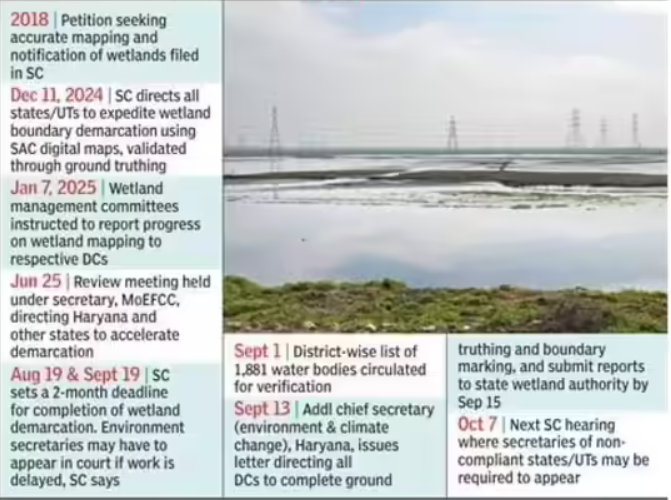Haryana Undertakes Wetland Verification | 07 Oct 2025
Why in News?
The Haryana government has instructed all deputy commissioners (DCs) to complete the ground verification and digital boundary demarcation of 1,881 wetlands identified across the state, following the Supreme Court's directive.
- This order comes after the Supreme Court's warning regarding non-compliance with the deadline, with the court issuing an ultimatum for environment secretaries of non-compliant states to appear before it on 7th October 2025.
Key Points
- Objective: Wetland demarcation and protection are crucial for environmental preservation and will form the basis for their legal notification under the Wetlands (Conservation and Management) Rules, 2017.
- Ground truthing, the verification of satellite data accuracy, is essential to correctly identify and protect water bodies that were previously excluded from earlier satellite-based maps.
- Categories:
- Man-Made Wetlands: Total 25,606 wetlands covering 23,527.1 hectares, making up 63.61% of the total wetland area. These are mainly artificial ponds, tanks, and waterlogged areas.
- Natural Wetlands: Total 13,141.1 hectares, constituting 35.53% of the wetland area, playing a critical role in biodiversity and ecological balance.
- District-wise Distribution: Wetland distribution in Haryana's districts varies, with Panchkula having the highest share at 2.95%, followed by Yamunanagar at 2.20%, Faridabad at 1.72%, while the smallest share is in Mahendragarh (0.16%) and Kurukshetra (0.08%).
Wetlands and Ramsar Convention
- About Wetlands: They are areas of marsh, fen, peatland, or water (natural or artificial) with water that is static or flowing, including marine areas with a depth not exceeding six meters.
- Wetlands are an ecotone, having land transitional between terrestrial and aquatic ecosystems.
- About Ramsar Convention: It was adopted in 1971 in Ramsar, Iran, and provides a global framework for wetland conservation and wise use. India joined it in 1982.
- The Montreux Record (threatened list) lists wetlands with deteriorating ecological character due to human activity or pollution.

